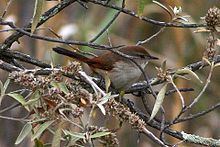Order Passeriformes Genus Asthenes Higher classification Canastero | Phylum Chordata Family Furnariidae Scientific name Asthenes dorbignyi Rank Species | |
 | ||
Similar Steinbach's canastero, Cordilleran canastero, Canyon canastero, Patagonian canastero, Short‑billed canastero | ||
The rusty-vented canastero (Asthenes dorbignyi), also known as the creamy-breasted canastero, is a species of bird in the family Furnariidae. It is found in South America.
Contents
Description
The creamy-breasted canastero is brown or rufous brown above, usually with a rufous rump, and with pale gray or whitish underparts (throat, breast, and belly). The tail is blackish, but the outer rectrices are rufous, buffy or whitish in color.
The creamy-breasted canastero is common in most areas within its range, but some subspecies are restricted to small geographic areas and so potentially are vulnerable to habitat loss or degradation.
Taxonomy
The taxonomy of the creamy-breasted canastero is complicated. There are five subspecies: arequipae of southwestern Peru, western Bolivia, and northern Chile; huancavelicae and usheri, both found in south central Peru; consobrina of southwestern Bolivia, and dorbignyi of central Bolivia and northwestern Argentina. Some authors have grouped these into as many as three separate species: Dark-winged canastero Asthenes arequipae; pale-tailed canastero Asthenes huancavelicae (including the subspecies huancavelicae and usheri); and the rusty-vented canastero Asthenes dorbignyi (including the subspecies consobrina and dorbignyi). Currently, however, most authorities include all five into the single species creamy-breasted canastero, but there is widespread acknowledgement that the taxonomy of this species requires more research. Also, it is possible that creamy-breasted canastero is not a member of the genus Asthenes at all, but instead belongs to the genus Phacellodomus.
Distribution and habitat
It is found in the Andes Mountains in Peru, Chile, Bolivia, and northwestern Argentina. Its habitat is montane scrub or open Polylepis forest.
